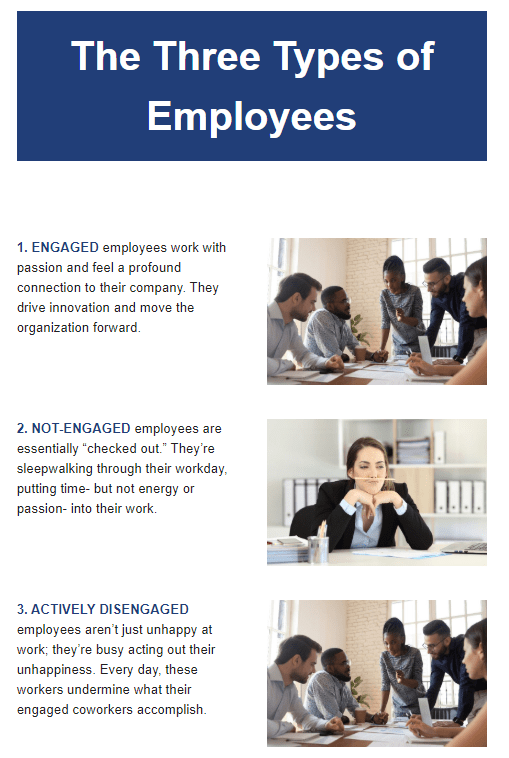8 Ways to Improve Employee Engagement and Drive Workforce Improvements
In the year 2020 and beyond, what are you doing to ensure your employees remain engaged in today’s competitive workforce?
A strong workforce displays an environment of trust, inclusivity, diversity and powerful conversations. Organizations that thrive consistently deliver value to their customers and their employees. Establishing a place where your human capital thrives begins with understanding how employees maintain engagement, as well as how they begin to disengage within their teams. Recognizing the patterns displayed by individuals at every level within an organization, from executives down to associates, will allow leaders to understand how to improve their overall organizational culture.
“Everybody who wants to be trusted is not trustworthy. Building trust in the workplace is critical to morale and productivity.”
The following are actionable items you can use to optimize engagement within your organization.
- Develop Managers to Lead Powerfully in Your Place
Managers across many departments have the ability to produce powerful teams that feel valued in their time, energy, and professional input. It is just as important for managers to emulate the mission and vision of an organization as it is for the executive leadership team. Managers have the responsibility of translating key initiatives from the executive leaders to their teams. Creating an inspiring workforce that understands feedback is not a way to reprimand – it’s a way to grow, develop and help employees establish a place in the organization that can be felt for many years.
“When I think about leadership versus management this is what comes to my mind. Managers are task oriented while leaders are relationship focus.”
Integrate Strategies to Gauge and Improve Employee Engagement
- Acknowledge when your employees go above and beyond.
- Build on their needs outside of their salary and bonuses.
- Create a reward system that promotes innovation.
- Invest in team-building workshops.
- Conduct regular surveys and assessments by departments.
- Monitor Retention and Conduct Exit Interviews when Employees Leave
High retention and low-turnover are possible when a culture is created that meets the needs and desires of the employees, and not just the leadership team. Employees know they are expected to add value to customers, optimize revenue and streamline operations. Leaders must recognize an employee’s drive to accomplish these tasks begins with the human capital within. When an employee decides to leave or has to be let go, it’s important to conduct an exit interview to understand why. Document the events that led up to departure and relay that information to managers. Exit interviews empower leaders to assess the needs of the remaining employee, as well as anticipate needs of future ones.
“Employees don’t quit jobs they quit bosses.”
Workplace motivation for employees, such as investing in their education and offering a robust and competitive compensation package, improves employee morale, which translates into an improvement in a company’s overall health. It’s also important for managers to communicate to employees where the company currently stands and where the company hopes to be in the future and solicit their input on how the company can best reach its ultimate goal. Their opinions matter. Make that known. Foster a team environment over a leadership vs employee environment.
It’s time for employee engagement to go beyond performance reviews generated solely by computed metrics in company reports. Your employees are people at their core; they are not just numbers.
Employees are looking for leaders who implement new, cutting-edge processes and systems to improve their workflow automation and make their workdays better. Employees do not want to watch their jobs be replaced by technology; they want their jobs to be long-lasting, fulfilling careers. They want challenges that help improve their company and departments, as well as their own expertise. Employees need to be able to envision their 5-year, 10-year and 20-year path with the company.
People spend a great deal of their waking hours at work, and they want that time to be pleasant, as well as challenging and rewarding. Work is a place many value almost as much as their personal lives, so it’s time to grow employees in the same way organizations grow their profits. Expanding on their strengths and working past their weaknesses to turn them into learning experiences will keep an organization’s employees productive and always looking for the next challenge.
“Some surveys have indicated that people spend roughly 65% of the life at work.”
Are you focusing on their future through powerful conversations? Or are you coaching them solely based on numbers?
So how can leaders do this while creating an effective workforce?
When creating an environment where employees are engaged, it is integral to lead by showing employees the ways they can grow within. Engagement can occur when defining roles and responsibilities, acknowledging cross-functional contributions to the organization, and giving employees opportunities to develop personally and professionally through various programs. Investing in your organization through employee development and care allows for department leaders to maintain a level of skill and accuracy as work is accomplished.
Before looking at the different ways to drive effectiveness in the workplace, take a look at the different types of “engagement” experienced with different employees:
- Engaged: Employees work with passion and feel a profound connection to their company. They drive innovation and move the organization forward.
- Non-Engaged: Employees are essentially “checked out.” They’re sleep walking through their workday, putting time – but not energy or passion – into their work.
- Actively Disengaged: Employees aren’t just unhappy at work; they’re busy acting out their unhappiness. Every day, these workers undermine what their engaged coworkers accomplish.

- Emulate the Behavior You Expect
Embody the company’s vision and mission in the eyes of the employees. Representing the company in the best way possible will allow managers to train and develop talent in the same way the executives have developed them as managers.
- Keep an Open Dialogue Around Performance Benchmarks
Develop your talent through routine conversations about where they are and where they want to go. This provides the greatest ROI (return on investment) in workforce productivity and will allow for talent to turn ideas into new projects, new products, and new profit. Use KPIs (Key Performance Indicators) to drive conversations and coaching sessions. Step away from using numbers as the key indicator that depicts their worth to the organization; talk about what they did differently or could have done differently to improve their metrics, then create an action plan to do so.
- Create Manageable Challenges
Understand how they want to be challenged, and if they aren’t, where they fit best within the organization. This takes your employees a step beyond routine performance evaluations and makes certain they are a good fit with their department and the organization as a whole.
- Solicit Feedback from Everyone
Employ and train managers to solicit feedback on the organization from employees. Executives do not have time to solicit feedback from every individual employee; this is a reality we have to live with. It’s important that managers emulate the behaviors of executive leaders and provide feedback about leadership practices and improve themselves as well. When employees know their voices are heard, they will continue to strive to be better and work hard for the organization. Your employees are more than employees, they are the human capital that helps execute your bottom line. They are an integral part of your organizational structure and culture.
- Work on Earning the Trust of Your Employees
The industry standard over the past decade emphasized the use of performance metrics, KPIs, and overall assessing employees through numbers – and it has also contributed to the drop in employee engagement and increased turnover rates for those who can feel the effects of being analyzed by a machine. It’s time to leverage both analytical and interpersonal strategies to create high-trust and high-engagement among employees from the bottom up. Employees with a high level of trust will establish an identity with the organization and continue to grow and learn with their leaders. The speed of innovation is far greater in environments where employees trust their leaders and the culture they have developed.
Employees will follow leaders with an understanding of shortcomings or mistakes and they will continue to follow them with confidence.
As technology advances and more roles are created than people each day, leadership in organizations of all sizes must understand how to maintain a strong employee base of talented individuals that feel valued. More than ever, employees are looking to their managers, executive team members, and peers for constructive feedback that helps them work better and optimize their personal and professional growth. Management teams must develop systems and processes that remove barriers to communication and improve interpersonal challenges.
If leaders truly understand the needs of a productive workforce, it will be easy to identify when employees are engaged and when one needs to improve how the teams are managed. Investing in employee development will create a culture of individuals who actively put their best foot forward and truly want to succeed within an organizational environment. True workforce engagement inspires employees to share a message with their peers and to the community that surrounds them outside of work. Employees will feel a sense of pride and purpose no matter what role they represent. Create company advocates that know their voices are heard from within to improve how your company is perceived by the outside world.

